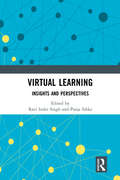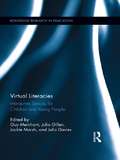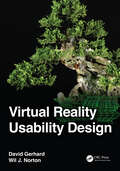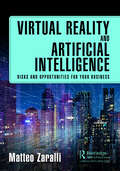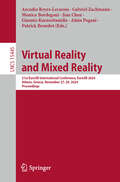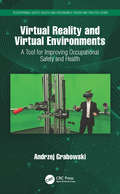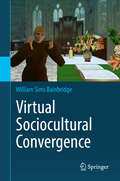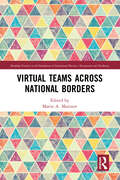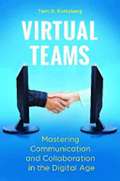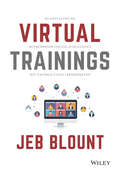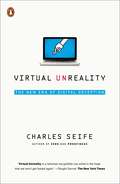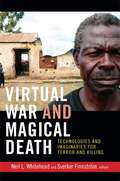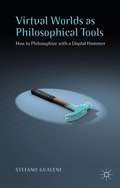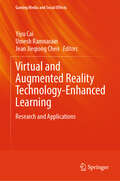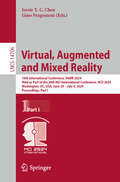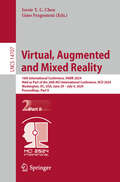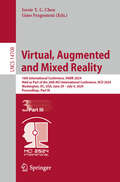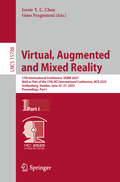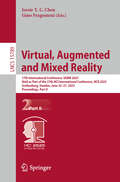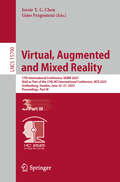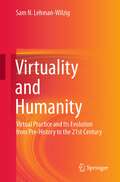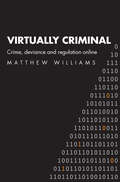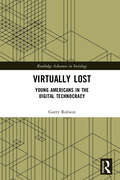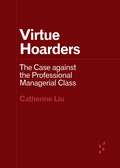- Table View
- List View
Virtual Learning: Insights and Perspectives
by Ravi Inder Singh Pooja SikkaThis book brings together the research work conducted by renowned academics and practitioners on critical and immensely important issues of virtual learning. It provides innovative ideas and empirical findings on the subject. The sixteen chapters by established and young scholars from all over the country offer strong theoretical and analytical discussion, and examine a wide range of issues confronting the education sector in India in general and the higher education sector in particular. The book seeks to address pertinent issues relating to virtual learning like emerging scenario with respect to required changes in pedagogy used in higher education learning, perceptions of learners about online mode of learning, problems and challenges in virtual learning, paradigm shifts in higher education, designing of new learning strategies for online mode of learning and about the role virtual learning plays in inclusive growth. The scholarly discussion of the book will serve as an excellent vade mecum for readers who want to understand the various dimensions of virtual learning, specifically those that emerged during the Covid-19 Pandemic period, and will provide opportunities to researchers to use it as reference to pursue research in the field of virtual learning.
Virtual Literacies: Interactive Spaces for Children and Young People (Routledge Research in Education #84)
by Julia Gillen Jackie Marsh Guy Merchant Julia DaviesThe growth of interest in virtual worlds and other online spaces for children and young people raises important issues for literacy educators and researchers. This book is a timely and much-needed collection of current research in the area. It provides a synthesis of knowledge and understanding and will be a key resource for scholars, students and teachers, particularly those interested in digital literacies. The work presents a coherent vision of current knowledge, and some of the most engaging, empirical research being undertaken on virtual worlds and online spaces in and beyond educational institutions. It contains international studies from the UK, North America and Australasia. This is an important time for those researching virtual worlds, videogaming and Web 2.0 technologies, since there is growing professional interest in their significance in the education and development of children and young people. Whether these technologies are solely associated with informal learning or whether they should be incorporated into classroom contexts is hotly debated. This book provides a principled evaluation and appreciation of the learning, teaching and instruction that can occur in digital environments, showing children, young people and those who work with them as active agents with possibilities to navigate new paths.
Virtual Reality Usability Design
by David Gerhard Wil J. NortonThe development of effective and usable software for spatial computing platforms like virtual reality (VR) requires an understanding of how these devices create new possibilities (and new perils) when it comes to interactions between humans and computers. Virtual Reality Usability Design provides readers with an understanding of the techniques and technologies required to design engaging and effective VR applications. The book covers both the mechanics of how human senses and the mind experience immersive virtual environments, as well as how to leverage these mechanics to create human-focused virtual experiences. Deeply rooted in principles of human perception and computational interaction, the current and future limitations of these replacements are also considered. Full of real-world examples, this book is an indispensable guide for any practising VR developer interested in making efficient and effective interfaces. Meanwhile, explorations of concrete theory in their practical application will be useful for VR students and researchers alike.
Virtual Reality and Artificial Intelligence: Risks and Opportunities for Your Business
by Matteo ZaralliTechnology is rapidly transforming the way people learn and train, and the integration of virtual reality (VR) and artificial intelligence (AI) could be the next big breakthrough. With the advent of Web 3.0 and the Metaverse, there are endless possibilities for creating immersive and engaging learning environments. However, there is also a need to address the risks and challenges that these technologies present.This book explores the risks and opportunities of VR and AI for coaching and training, with an eye toward the emerging trends of Web 3.0 and the Metaverse. Coaching and training have become increasingly important for companies seeking to develop and retain talent. With the advent of VR and AI technology, there is an opportunity to create immersive and engaging learning environments that could greatly enhance the learning experience. However, there are also risks associated with the use of these technologies, such as data privacy and cybersecurity.This book provides an in-depth analysis of the risks and opportunities of VR and AI for coaching and training, to help startup and business executives understand how to use these technologies responsibly and effectively. We need a new perspective. The book discusses the intersection of various major subjects and topics: business, innovation, technology, and philosophy in terms of critical thinking. The transition we are experiencing through this new Intelligent Revolution is very important, and soon everyone will witness the shift from e-learning to v-learning.
Virtual Reality and Mixed Reality: 21st EuroXR International Conference, EuroXR 2024, Athens, Greece, November 27–29, 2024, Proceedings (Lecture Notes in Computer Science #15445)
by Monica Bordegoni Jian Chen Arcadio Reyes-Lecuona Patrick Bourdot Gabriel Zachmann Giannis Karaseitanidis Alain PaganiThis book constitutes the refereed proceedings of the 21st International Conference on Virtual Reality and Mixed Reality, EuroXR 2024, held in Athens, Greece, during November 27–29, 2024. The 14 full papers presented together with 1 short paper were carefully reviewed and selected from 47 submissions. The papers are grouped into the following topics: Designing Experiences, Human Factors, Rendering and Visualization, Interaction Techniques, and Education and Training. EuroXR aims to foster engagement between European industries, academia, and the public sector, to promote the development and deployment of XR tech niques in new and emerging, but also in existing fields.
Virtual Reality and Virtual Environments: A Tool for Improving Occupational Safety and Health (Occupational Safety, Health, and Ergonomics)
by Andrzej GrabowskiVirtual reality (VR) techniques are becoming increasingly popular. The use of computer modeling and visualization is no longer uncommon in the area of ergonomics and occupational health and safety. This book explains how studies conducted in a simulated virtual world are making it possible to test new solutions for designed workstations, offering a high degree of ease for introducing modifications and eliminating risk and work-related accidents. Virtual reality techniques offer a wide range of possibilities including increasing the cognitive abilities of the elderly, adapting workstations for people with disabilities and special needs, and remote control of machines using collaborative robots.Detailed discussions include: Testing protective devices, safety systems, and the numerical reconstruction of work accidents Using computer simulation in generic virtual environments On the one hand, it is a self-study book made so by well-crafted and numerous examples. On the other hand, through a detailed analysis of the virtual reality from a point of view of work safety and ergonomics and health improvement. Ewa Grabska, Jagiellonian University, Kraków, PolandNoteworthy is the broad scope and diversity of the addressed problems, ranging from training employees using VR environments with different degrees of perceived reality; training and rehabilitation of the elderly; to designing, testing, modifying, and adapting workplaces to various needs including those of disabled workers; to simulation and investigation of the cause of accidents at a workplace.Andrzej Krawiecki, Warsaw University of Technology, Warsaw, Poland
Virtual Sociocultural Convergence
by William Sims BainbridgeThis book explores the remarkable sociocultural convergencein multiplayer online games and other virtual worlds, through the unificationof computer science, social science, and the humanities. The emergence of online media provides notonly new methods for collecting social science data, but also contexts fordeveloping theory and conducting education in the arts as well astechnology. Notably, role-playing gamesand virtual worlds naturally demonstrate many classical concepts about human behaviour,in ways that encourage innovative thinking. The inspiration derives from the internationally shared values developedin a fifteen-year series of conferences on science and technology convergence. The primary methodology is focused on sending avatars, representingclassical social theorists or schools of thought, into online gameworlds thatharmonize with, or challenge, their fundamental ideas, including technologicaldeterminism, urban sociology, group formation, freedom versus control, classstratification, linguistic variation, functional equivalence across cultures, behaviouralpsychology, civilization collapse, and ethnic pluralism. Researchers and students in the social and behaviouralsciences will benefit from the many diverse examples of how both qualitativeand quantitative science of culture and society can be performed in onlinecommunities of many kinds, even as artists and gamers learn styles and skillsthey may apply in their own work and play.
Virtual Teams Across National Borders (Routledge Frontiers in the Development of International Business, Management and Marketing)
by Marin A. MarinovVirtual teams can be traced back to the 1990s with the debauched development of communication technologies as well as the fast extension of the internet. Virtual teams possess unique features allowing them to combine cultural multiplicity, specific tasks, physical remoteness of team members, continuous distant communication, critical interdependence of tasks, leadership, cohesion, empowerment, confidence, virtuality, special trust creation and trust building. For a successful functioning of present-day organisations, they need to employ geographically dispersed labour force. Creating virtual teams functioning across national borders, organisations secure the most competent talent available world-wide. Employing the best available know-how, virtual teams apply the knowledge of experts from various cultures having diverse capabilities as well as varied perceptions on dealing with multiple organisational challenges from strategic perspectives. Compositions of virtual teams operating across national borders alter depending on types of industry, organisation, and organisational unit. International virtual teams functioning across national borders perform from practically everywhere all over the world if there is a secure and constant internet connection. This book is dedicated to offering a comprehensive outlook and analysis of the theoretical and practical aspects related to the creation of virtual teams across national borders as well as the specifics of their implementation. The research, published as chapters in the book, allow the detection of the key aspects and trends concerning the creation and performance of virtual teams across national borders. The book presents topics, not being investigated in-depth so far or not researched at all. The purpose of the book is to fill in certain gaps in the existing research and subsequent publications, referring to a broad variety of issues concerning theoretical and empirical fundamentals of the creation of virtual teams and their functioning across national borders, the role of virtual intelligence in relation to distance interpretation in international virtual teams, geography of virtual teams in relation to digital nomads, communication in virtual teams, creation of communal identity via implementation of virtual teams, tax implications for virtual work among numerous other issues.
Virtual Teams: Mastering Communication And Collaboration In The Digital Age
by Terri R. KurtzbergElectronic communication is now embedded in our daily experience, as is work involving off-site collaborators. Virtual communication has become an essential job skill that is critical to individual and group success, yet most people just muddle through it without giving it any thought. Drawing on decades of scientific research in the fields of psychology, organizational behavior, and sociology, this book explains how to master the art and science of communicating virtually. <p><p> The author first analyzes the subtle but significant changes that result when conversations are moved online, providing examples and tips to avoid common pitfalls, then discusses how team behavior and decision making can best be guided in this realm. Readers will fully understand what makes teams "click"--what inspires trust, how to get a team "off on the right foot," and what steps to take in order to make good collaborative decisions--as well as other key topics for virtual teamwork, such as best practices for working in the cross-cultural environment. The book serves as an ideal guide for anyone who participates in or manages a virtual team but is also suitable as a supplemental textbook in a business school course on organizational behavior or business communication.
Virtual Trainings: So gestalten Sie mitreissende Online-Schulungen mit nachhaltigen Lerneffekten
by Jeb BlountDie weltweite Pandemie beschleunigte die breite Einführung virtueller Trainings. Diese Trainingsform kombiniert die Struktur, die Verantwortlichkeit und die Vorteile des sozialen Lernens vor Ort im Klassenzimmer mit Geschwindigkeit, Flexibilität und erheblichen Kosteneinsparungen. Virtuelle Schulungen sind auà erdem umweltfreundlich. Die gröà te Herausforderung beim virtuellen Training und der Grund für den groà en Widerstand dagegen ist jedoch, dass die Erfahrung in der Vergangenheit sehr mühsam war. Das liegt nicht an der Qualität des Lehrplans oder des Inhalts. Auch nicht am Talent des Trainers. Es ist die Lernerfahrung. Es gibt nur wenige Menschen, die noch nie das "Vergnügen" hatten, sich durch quälende virtuelle Trainings-Sessions zu schleppen. Der Tod durch Voice-over-PowerPoint, vorgetragen von einem desinteressierten Ausbilder, hat einen besonders bitteren Beigeschmack. Es ist die Art und Weise, wie virtuelle Trainings durchgeführt werden, die am wichtigsten ist. Wenn die virtuelle Lernerfahrung emotional positiv ist, sind die Teilnehmer beispielsweise engagierter, eignen sich neue Kompetenzen an und das Wissen bleibt haften. Auà erdem buchen Führungskräfte mehr virtuelle Trainings und Unternehmen integrieren virtuelle Trainings leichter in ihre Lern- und Entwicklungsinitiativen. Genau darum geht es in diesem Buch. "Virtual Trainings" ist der maà gebliche Leitfaden für die Durchführung virtueller Schulungen, die die Lernenden fesseln und neue Fähigkeiten und Verhaltensänderungen nachhaltig vermitteln. Jeb Blount, einer der bekanntesten Trainer und Autoren unserer Generation, führt Sie Schritt für Schritt durch die sieben Elemente effektiver, ansprechender virtueller Lernerfahrungen: Trainer-Mentalität & emotionale Disziplin, Produktion & Technologie, Medien & Visuelles, virtuelles Curriculum & Lehrplangestaltung, Planung & Vorbereitung, virtuelle Kommunikationsfähigkeiten, dynamische und interaktive Durchführung von Schulungen. Mit jedem neuen Kapitel werden Sie mehr und mehr Vertrauen in Ihre Fähigkeit gewinnen, Trainings in einem virtuellen Klassenzimmer effektiv durchzuführen. Wenn Sie erst einmal die virtuelle Durchführung von Schulungen beherrschen und die Vorteile des Fernunterrichts kennengelernt haben, werden Sie vielleicht nie wieder in ein physisches Klassenzimmer zurückkehren wollen.
Virtual Unreality
by Charles SeifeThe bestselling author of Proofiness and Zero explains how to separate fact from fantasy in the digital world Digital information is a powerful tool that spreads unbelievably rapidly, infects all corners of society, and is all but impossible to control--even when that information is actually a lie. In Virtual Unreality, Charles Seife uses the skepticism, wit, and sharp facility for analysis that captivated readers in Proofiness and Zero to take us deep into the Internet information jungle and cut a path through the trickery, fakery, and cyber skullduggery that the online world enables. Taking on everything from breaking news coverage and online dating to program trading and that eccentric and unreliable source that is Wikipedia, Seife arms his readers with actual tools--or weapons--for discerning truth from fiction online.
Virtual Unreality
by Charles SeifeThe bestselling author of Proofiness and Zero explains how to separate fact from fantasy in the digital world Digital information is a powerful tool that spreads unbelievably rapidly, infects all corners of society, and is all but impossible to control--even when that information is actually a lie. In Virtual Unreality, Charles Seife uses the skepticism, wit, and sharp facility for analysis that captivated readers in Proofiness and Zero to take us deep into the Internet information jungle and cut a path through the trickery, fakery, and cyber skullduggery that the online world enables. Taking on everything from breaking news coverage and online dating to program trading and that eccentric and unreliable source that is Wikipedia, Seife arms his readers with actual tools--or weapons--for discerning truth from fiction online.
Virtual War and Magical Death: Technologies and Imaginaries for Terror and Killing
by Neil L. Whitehead Sverker FinnströmVirtual War and Magical Death is a provocative examination of the relations between anthropology and contemporary global war. Several arguments unite the collected essays, which are based on ethnographic research in varied locations, including Guatemala, Uganda, and Tanzania, as well as Afghanistan, Pakistan, Iraq, and the United States. Foremost is the contention that modern high-tech warfare--as it is practiced and represented by the military, the media, and civilians--is analogous to rituals of magic and sorcery. Technologies of "virtual warfare," such as high-altitude bombing, remote drone attacks, night-vision goggles, and even music videoes and computer games that simulate battle, reproduce the imaginative worlds and subjective experiences of witchcraft, magic, and assault sorcery long studied by cultural anthropologists. <P><P> Another significant focus of the collection is the U. S. military's exploitation of ethnographic research, particularly through its controversial Human Terrain Systems (HTS) Program, which embeds anthropologists as cultural experts in military units. Several pieces address the ethical dilemmas that HTS and other counterinsurgency projects pose for anthropologists. Other essays reveal the relatively small scale of those programs in relation to the military's broader use of, and ambitions for, social scientific data.
Virtual Worlds As Philosophical Tools
by Stefano Gualeni• What does it mean for human beings to 'be' in simulated worlds? • Will experiencing worlds that are not 'actual' change our ways of structuring thought? • Can virtual worlds open up new possibilities to philosophize? Inspired by Martin Heidegger's work,Virtual Worlds as Philosophical Tools seeks to answer these questions from a perspective that combines insights from the field of philosophy of technology with videogame design. Gualeni's exploration casts new light on interactive digital simulations as the context in which a new humanism has already begun to arise. From that perspective, this book articulates an understanding of virtual worlds as philosophical mediators.
Virtual and Augmented Reality Technology-Enhanced Learning: Research and Applications (Gaming Media and Social Effects)
by Yiyu Cai Umesh Ramnarain Jean Jieqiong ChenThis book consists of chapters that present the state-of-the-art research and applications of Virtual & Augmented Reality Technology-enhanced Learning (VARTeL). The chapters of the book present a multi-facet view on different approaches to deal with challenges that surround the uptake of educational applications of mixed reality, simulations, and serious games in various practices. The different approaches highlight challenges and potential solutions and provide future directions for mixed reality, simulation, and serious games research, for the design of learning material and for implementation. By doing so, the book is a useful resource for both students and scholars interested in research in this field, for designers of learning material, and for practitioners that want to embrace mixed reality, simulation, and/or serious games in their education.
Virtual, Augmented and Mixed Reality: 16th International Conference, VAMR 2024, Held as Part of the 26th HCI International Conference, HCII 2024, Washington, DC, USA, June 29 – July 4, 2024, Proceedings, Part I (Lecture Notes in Computer Science #14706)
by Gino Fragomeni Jessie Y. C. ChenThis three-volume set LNCS 14706-14708 constitutes the refereed proceedings of the 16th International Conference on Virtual, Augmented and Mixed Reality, VAMR 2024, held as part of the 26th International Conference, HCI International 2024, in Washington, DC, USA, during June 29 – July 4, 2024. The total of 1271 papers and 309 posters included in the HCII 2024 proceedings was carefully reviewed and selected from 5108 submissions. The VAMR 2024 proceedings were organized in the following topical sections: Part I: : Perception, Interaction and Design; User Experience and Evaluation. Part II: Immersive Collaboration and Environment Design; Sensory, Tangible and Embodied Interaction in VAMR. Part III: Immersive Education and Learning; VAMR Applications and Development.
Virtual, Augmented and Mixed Reality: 16th International Conference, VAMR 2024, Held as Part of the 26th HCI International Conference, HCII 2024, Washington, DC, USA, June 29 – July 4, 2024, Proceedings, Part II (Lecture Notes in Computer Science #14707)
by Gino Fragomeni Jessie Y. C. ChenThis three-volume set LNCS 14706-14708 constitutes the refereed proceedings of the 16th International Conference on Virtual, Augmented and Mixed Reality, VAMR 2024, held as part of the 26th International Conference, HCI International 2024, in Washington, DC, USA, during June 29 – July 4, 2024. The total of 1271 papers and 309 posters included in the HCII 2024 proceedings was carefully reviewed and selected from 5108 submissions. The VAMR 2024 proceedings were organized in the following topical sections: Part I: : Perception, Interaction and Design; User Experience and Evaluation. Part II: Immersive Collaboration and Environment Design; Sensory, Tangible and Embodied Interaction in VAMR. Part III: Immersive Education and Learning; VAMR Applications and Development.
Virtual, Augmented and Mixed Reality: 16th International Conference, VAMR 2024, Held as Part of the 26th HCI International Conference, HCII 2024, Washington, DC, USA, June 29 – July 4, 2024, Proceedings, Part III (Lecture Notes in Computer Science #14708)
by Gino Fragomeni Jessie Y. C. ChenThis three-volume set LNCS 14706-14708 constitutes the refereed proceedings of the 16th International Conference on Virtual, Augmented and Mixed Reality, VAMR 2024, held as part of the 26th International Conference, HCI International 2024, in Washington, DC, USA, during June 29 – July 4, 2024. The total of 1271 papers and 309 posters included in the HCII 2024 proceedings was carefully reviewed and selected from 5108 submissions. The VAMR 2024 proceedings were organized in the following topical sections: Part I: : Perception, Interaction and Design; User Experience and Evaluation. Part II: Immersive Collaboration and Environment Design; Sensory, Tangible and Embodied Interaction in VAMR. Part III: Immersive Education and Learning; VAMR Applications and Development.
Virtual, Augmented and Mixed Reality: 17th International Conference, VAMR 2025, Held as Part of the 27th HCI International Conference, HCII 2025, Gothenburg, Sweden, June 22–27, 2025, Proceedings, Part I (Lecture Notes in Computer Science #15788)
by Gino Fragomeni Jessie Y. C. ChenThis three-volume set, LNCS 15788-15790, constitutes the refereed proceedings of the 17th International Conference on Virtual, Augmented and Mixed Reality, VAMR 2025, held as part of the 27th International Conference on Human-Computer Interaction, HCII 2025, in Gothenburg, Sweden, during June 22–27, 2025. The total of 1430 papers and 355 posters included in the HCII 2025 proceedings were carefully reviewed and selected from 7972 submissions. The papers presented in these three volumes are organized in the following topical sections:: Part I: Designing and Developing Virtual Environments; UX in Virtual Environments Part II: VR, Culture, Art and Entertainment; Social Interaction and Wellbeing in Virtual Environments Part III: VR Games; Virtual Environments for Learning, Training and Professional Development; Multimodal Interaction in Virtual Environments
Virtual, Augmented and Mixed Reality: 17th International Conference, VAMR 2025, Held as Part of the 27th HCI International Conference, HCII 2025, Gothenburg, Sweden, June 22–27, 2025, Proceedings, Part II (Lecture Notes in Computer Science #15789)
by Gino Fragomeni Jessie Y. C. ChenThis three-volume set, LNCS 15788-15790, constitutes the refereed proceedings of the 17th International Conference on Virtual, Augmented and Mixed Reality, VAMR 2025, held as part of the 27th International Conference on Human-Computer Interaction, HCII 2025, in Gothenburg, Sweden, during June 22–27, 2025. The total of 1430 papers and 355 posters included in the HCII 2025 proceedings were carefully reviewed and selected from 7972 submissions. The papers presented in these three volumes are organized in the following topical sections:: Part I: Designing and Developing Virtual Environments; UX in Virtual Environments Part II: VR, Culture, Art and Entertainment; Social Interaction and Wellbeing in Virtual Environments Part III: VR Games; Virtual Environments for Learning, Training and Professional Development; Multimodal Interaction in Virtual Environments
Virtual, Augmented and Mixed Reality: 17th International Conference, VAMR 2025, Held as Part of the 27th HCI International Conference, HCII 2025, Gothenburg, Sweden, June 22–27, 2025, Proceedings, Part III (Lecture Notes in Computer Science #15790)
by Gino Fragomeni Jessie Y. C. ChenThis three-volume set, LNCS 15788-15790, constitutes the refereed proceedings of the 17th International Conference on Virtual, Augmented and Mixed Reality, VAMR 2025, held as part of the 27th International Conference on Human-Computer Interaction, HCII 2025, in Gothenburg, Sweden, during June 22–27, 2025. The total of 1430 papers and 355 posters included in the HCII 2025 proceedings were carefully reviewed and selected from 7972 submissions. The papers presented in these three volumes are organized in the following topical sections:: Part I: Designing and Developing Virtual Environments; UX in Virtual Environments Part II: VR, Culture, Art and Entertainment; Social Interaction and Wellbeing in Virtual Environments Part III: VR Games; Virtual Environments for Learning, Training and Professional Development; Multimodal Interaction in Virtual Environments
Virtuality and Humanity: Virtual Practice and Its Evolution from Pre-History to the 21st Century
by Sam N. Lehman-WilzigThis is a pioneering study of virtuality through human history: ancient-to-modern evolution and recent expansion; expression in many fields (chapters on Religion; Philosophy, Math, Physics; Literature and the Arts; Economics; Nationhood, Government and War; Communication); psychological and social reasons for its universality; inter-relationship with "reality." The book's thesis: virtuality was always an integral part of humanity in many areas of life, generally expanding over the ages. The reasons: 1- brain psychology; 2- virtuality's six functions — escape from boredom to relieving existential dread. Other questions addressed: How will future neuroscience, biotech and "compunications" affect virtuality? Can/should there be limits to human virtualizing?
Virtually Criminal: Crime, Deviance and Regulation Online
by Matthew WilliamsAmidst the sensationalist claims about the dangers of the Internet, Virtually Criminal provides an empirically grounded criminological analysis of deviance and regulation within an online community. It integrates theory and empiricism to forge an explanation of cybercrime whilst offering new insights into online regulation. One of the first studies to further our understanding of the causes of cyber deviance, crime and its control, this groundbreaking study from Matthew Williams takes the Internet as a site of social and cultural (re)production, and acknowledges the importance of online social/cultural formations in the genesis and regulation of cyber deviance and crime. A blend of criminological, sociological and linguistic theory, this book provides a unique understanding of the aetiology of cybercrime and deviance. Focus group and offence data are analyzed and an interrelationship between online community, deviance and regulation is established. The subject matter of the book is inherently transnational. It makes extensive use of a number of international case studies, ensuring it is relevant to readers in multiple countries (especially the US, the UK and Australasia). Pioneering and innovative, this fascinating book will be of interest to students and researchers across the disciplines of sociology, criminology, law and media and communication studies.
Virtually Lost: Young Americans in the Digital Technocracy (Routledge Advances in Sociology)
by Garry RobsonThis book examines the connections between the psycho-social difficulties and challenges faced by children and younger people in their online lives; the structure, character, and motivations of the corporate system ‘behind’ the screen; and the possibility that the digital technostructure may come to form the backbone of a new post-democratic system of technocratic governance. Much of the originality of this book lies in its blending of subjects that are not often combined, thereby offering a fresh perspective: ‘generation studies’; the philosophy of technology; the history of the idea of technocracy; the technologically enhanced merger of corporate・governmental power in the U.S. system; the society-shaping goals and capabilities of the big tax-exempt American foundations over the last hundred years; the elite ‘superclass’ gaming of formally constituted transnational and global institutions; and the way the United Nations-centred SDG・ESG system is itself developing in the direction of a technocratic system of economic and population management. The book will appeal to readers interested in relationships between our contemporary global power elite, the structures it has created and processes it has set in motion, and how these affect young people whose development is already being over-determined by the activities of the big Silicon Valley entities and their associates.
Virtue Hoarders: The Case against the Professional Managerial Class (Forerunners: Ideas First)
by Catherine LiuA denunciation of the credentialed elite class that serves capitalism while insisting on its own progressive heroism Professional Managerial Class (PMC) elite workers labor in a world of performative identity and virtue signaling, publicizing an ability to do ordinary things in fundamentally superior ways. Author Catherine Liu shows how the PMC stands in the way of social justice and economic redistribution by promoting meritocracy, philanthropy, and other self-serving operations to abet an individualist path to a better world. Virtue Hoarders is an unapologetically polemical call to reject making a virtue out of taste and consumption habits.Forerunners: Ideas First is a thought-in-process series of breakthrough digital publications. Written between fresh ideas and finished books, Forerunners draws on scholarly work initiated in notable blogs, social media, conference plenaries, journal articles, and the synergy of academic exchange. This is gray literature publishing: where intense thinking, change, and speculation take place in scholarship.
